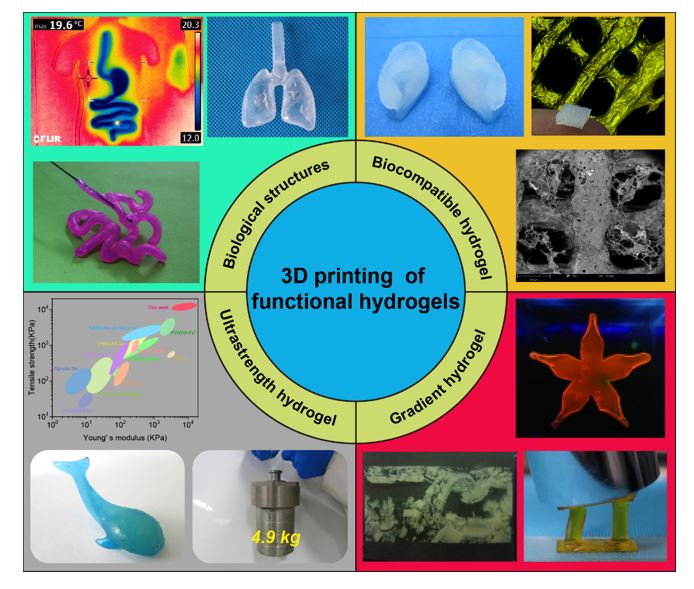Video Article Open Access
3D Printing of Functional Hydrogels
Pan Jiang1,2, Zhongying Ji1, Xiaolong Wang1,*
1State Key Laboratory of Solid Lubrication, Lanzhou Institute of Chemical Physics, Chinese Academy of Sciences, Lanzhou 730000, China
2Center of Materials Science and Optoelectronics Engineering, University of Chinese Academy of Sciences, Beijing 100049, China
Vid. Proc. Adv. Mater., Volume 2, Article ID 2103187 (2021)
DOI: 10.5185/vpoam.2021.03187
Publication Date (Web): 04 Aug 2021
Copyright © IAAM
Graphical Abstract

Abstract
Three-dimensional (3D) printing of hydrogels with the desirable structures and functions has been widely used in many fields, including biomedicine, soft robotics, flexible electronics, smart actuators, and so on. However, the current hydrogels still remain the fundamental challenges on the structural complexity, weak mechanical properties, uncontrollable physical-chemical properties for biomedical and engineering purposes. Herein, we propose novel strategies to 3D printing of functional hydrogels with the complex architectures, good mechanical performance and gradient heterogeneity in physical-chemical properties. A series of physical crosslinking hydrogels were 3D printed to achieve the hydrogels with the biological geometries, outstanding biocompatibility, swelling-resistance, and the ultrahigh strength and toughness. Specifically, the printed thermoreversible gelatine/carrageenan hydrogel templates combined with the surface supramolecular assembly process were used to construct the biological hollow-hydrogel structures, such as branched vascular replicas for simulating the guidewire navigation, digestive system for in vitro drug delivery, distal lung subunit, and glomerulus with outstanding mechanical robustness and favorable physiological environments. Moreover, direct ink writing of (polyvinyl alcohol (PVA) and κ-carrageenan) hybrid hydrogel ink with outstanding rheology and thixotropy achieved the pure physical crosslinking hydrogel scaffolds and biological objects with good mechanical properties, biocompatibility, as well as bioactivity, in which cells not only attach well to the surface of the hydrogels, but also stretch into the spaces in the grid architectures, providing appropriate microenvironments for cell culture. In fact, 3D printing of hydrogels with high intrinsic mechanical performance is of significant engineering applications in artificial cartilage, soft robotics and impact-resistant devices yet has been proven to be a fundamental challenge. We propose a novel strategy of dual physical crosslinking (DPC) networks based on PVA and chitosan (CS) to realize the 3D printing of ultrahigh strength hydrogel. The cyclic freezing-thawing followed by sodium citrate solution soaking realize the first network of PVA crystallization and the second one of CS ionic interaction between amino and carboxyl groups, respectively. The printed DPC hydrogels display the optimized tensile strength of 12.71 ± 1.32 MPa at tensile strain of 302.27 ± 15.70%, Young’s modulus of 14.01 ± 1.35 MPa, elongation at break of 22.10 ± 2.36 MJ m-3 and toughness of 9.92 ± 1.05 kJ m-2 due to the efficient energy dissipation of stiff chitosan ionic network. This robust hydrogel 3D printing can readily realize not only hydrogel structures such as lattices, honeycombs and springs, but also secondary shaping hydrogel objects including whale, octopus and butterfly via the local DPC strategy. Finally, we provided the protocol, named as grayscale digital light process (G-DLP), to prepare the gradient hydrogel in three dimensions. The grayscale projection causes the difference of crosslinking density of hydrogel spatially, which resulted in the gradient heterogeneity in mechanical performance, swelling, wettability, transmittance, etc. As results, the bioinspired hydrogel actuators with the coding shape deformation and the hydrogel patterning with the high-definition and reversibility were realized. We believe that the 3D printing of functional hydrogels will pave the way towards various fields for extensive potentials including soft machine, biomedicine, tissue engineering, and bionic engineering.
Keywords
Hydrogel; 3D printing; organ replicas; actuation; ultrahigh strength and toughness.
Acknowledgement
The authors gratefully acknowledge the financial support from the National Key Research and Development Program of China (2016YFC1100401) and the National Natural Science Foundation of China (51775538, 51935012 and), the Key Research Program of Frontier Sciences (QYZDY-SSWJSC013) and the Western Light Project, CAS, and the Gansu Science & Technology Projects (18ZD2WA011, 17JR5RA318 and 17YF1FA139).
References
- P. Jiang, C. Yan, Y. Guo, X. Zhang, M. Cai, X. Jia, X. Wang, F. Zhou, Biomaterials Science, 2019, 7, 1805.
- P. Jiang, C. Yan, Z. Ji, Y. Guo, X. Zhang, X. Xin, X. Wang, F. Zhou, ACS Applied Materials & Interfaces, 2019, 11, 42586-42593.
- Z. Ji, C. Yan, B. Yu, X. Zhang, M. Cai, X. Jia, X. Wang, F. Zhou, Advanced Materials Technologies, 2019, 4, 1800713.
- P. Jiang, P. Lin, C. Yang, H. Qing, X. Wang, F. Zhou, Chemistry of Materials. 2020, 32, 9983-9995.
Biography
Xiaolong Wang is a full Professor at the Lanzhou Institute of Chemical Physics (LICP), Chinese Academy of Sciences (CAS). He joined the LICP in 2007 when he got his PhD in the major of Polymer Chemistry and physics at Lanzhou University. During his stay at the LICP, he spent a year (2010–2011) in Hong Kong Polytechnic University as a Research Associate and then two years (2011–2013) at the University of Western Ontario (Canada) as an Adjunct Professor. He was promoted to a full professor at LICP in 2014. From then on, he is leading a 15+ members research group at the State Key Laboratory of Solid Lubrication named as 3D printing Tribology Devices. His research interests focus on 3D printing, biomimetic lubrication, functional soft materials, and flexible electronics and his achievements have been published in more than 80 peer-reviewed papers with a current h-index of 36, and issued 20+ patents by the China National Intellectual Property Administration.
Video Proceedings of Advanced Materials

Upcoming Congress



